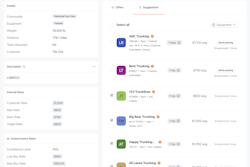With telematics devices of some sort on the majority of trucks on the road today, there is an untold amount of data that can be leveraged to help improve efficiency and lower risk for fleets.
Each year, telematics provider Lytx releases its State of the Data report, which provides insights on roadway risks and trends. The 2024 report, released at the end of May, was compiled from more than 40 billion miles of driving data from 2023.
Jeff Martin, Lytx’s vice president of global sales strategy, joins us this week to discuss the report and how fleets can use the data to their advantage.
Contents of this video
00:00 10-44 intro
00:29 Lytx’s State of the Data report
02:19 Top 10 risky driving behaviors
04:22 Riskiest U.S. public roadways
05:24 Riskiest U.S. states for driving
05:41 Riskiest U.S. cities for driving
06:15 Riskiest day of the week for driving
06:27 Riskiest holiday for driving
06:44 Using data to improve fleet operations
Jason Cannon:
CCJs 10 44 is brought to you by Chevron Delo heavy duty diesel engine oil. Now there's even more reasons to choose Delo,
Matt Cole:
What billions of miles worth of vehicle data for 2023 had to say about driving risks across the country.
Jason Cannon:
You're watching CCJs 10 44, a weekly episode that brings you the latest trucking industry news and updates from the editors of CCJ. Don't forget to subscribe and hit the bell for notifications so you'll never miss an installment of 10 44. Hey everybody, welcome back. I'm Jason Cannon and my co-host is Matt Cole with telematics devices in some form on the majority of trucks on the road today, there's an untold amount of data that can be leveraged to help improve efficiency and lower risk for fleets
Matt Cole:
Each year. Telematics provider Lytx releases its state of the data report, which provides insights on roadway risks and trends. The 2024 report released at the end of May was compiled from more than 40 billion miles of driving data from 2023. Jeff Martin Lytic is Vice President of Global Sales Strategy, joins us this week to discuss the report and how fleets can use the data to their advantage.
Jeff Martin:
This year, we're celebrating our 25th anniversary and we're really excited to release the 2024 state of the data report. We think it's going to tell a good story. The state of the data report originates from just over 40 billion miles of data in 2023, and the report identifies heightened levels of risks on roadways, all with a record level number of motorists on the roadways in 2023. As a matter of fact, 140 million behaviors were captured with 29 million of those being risky events being scored for coaching by a manager. The goal of annual report is to provide critical information to our customers as well as the general public as to the progress with regards to safe operating behaviors and overall roadway risk. Mitigation of unsafe behaviors is critically important as we all know. It's safe operating and we welcome and encourage everyone to be engaged. We can all agree on the importance of knowing how to drive safely as well as the understanding of the risks associated with when and where we're driving. This all becomes more vital and can play a significant role in overall fleet safety.
Jason Cannon:
Drilling down into the data, there's probably not a lot of surprises about what the riskiest driving behaviors were for 2023, speed following distance, seatbelt use, and the use of handheld devices. It's worth noting that lytic data spans numerous industries, and it's not just limited to trucking
Jeff Martin:
Overall, the top four behaviors were speed, seatbelt compliance following distance and handheld device or cell phone use following distance of one to two seconds remained as the number one riskiest behavior from the prior year of 2022. Handheld device or cell phone unfortunately rose a slot from number two or to number two from the prior year of number three. Seatbelt compliance actually improved a slot coming in at number three and posted speed violation remains stable year over year at number four. Also of the top 10 behaviors contributing to risk incomplete stop is new to the list for 2023, which is interesting. It should be mentioned that following distance of less than one second, less than one second increase from 10th place in 2022 to number five in 2023. Obviously this creates a greater urgency for fleets to decrease unsafe driving behaviors through video safety and telematics.
Matt Cole:
Lytx report also highlights the riskiest highways, cities, and states for unsafe driving behaviors. We'll hear where those are after our quick word from 10 44 sponsor Chevron lubricants.
Speaker 4:
We serve customers from Birmingham, Alabama to the Gulf Coast, so our people and our trucks are booked solid all day. There is no slack in our schedules. These trucks can't break down. I choose an engine oil that takes care of the number one issue with our engines emissions, so we don't have to worry about DPF clogging. I choose the engine oil that keeps our trucks hauling. I choose DELO 600 A DF.
Jeff Martin:
So if we start with, for example, the riskiest highways, the top five were near three major airports, actually two major airports, so third being not so major, but JFP and New York was the riskiest, the roadways surrounding the airport followed by Phoenix Sky Harbor at number two, and it's kind of a surprise with Reno Tahoe International Airport being number three. The report also identified roadways surrounding the Phoenix Convention Center as the fourth riskiest roadway system, and another surprise was number five with the Columbus Convention Center at number five, so wouldn't think of that, but statistics are good report card and obviously it's not considered a hotspot, but looking at those would be safe to say that lacking familiarity with roadways, exits, intersections, plus likely distractions likely are key factors of those situations. As for the riskiest states, California again was number one, followed by New York. Texas was number three and followed by Florida Number four, and a surprise was Pennsylvania at number five. Of note, California has been the riskiest state three times in the last four years. When you look at the cities, the riskiest cities were not a surprise given the population and number of motorists and infrastructure of the roadways, and so New York City was number one, followed by Los Angeles. Chicago was number three, and at manna was number four with Boston coming in at number five. Interestingly, at Manna moved up from number seven to number four, while Philadelphia moved down from number two to number eight.
Jason Cannon:
Jeff also mentions that the riskiest days of the week to drive may not be what you would expect
Jeff Martin:
For the riskiest day of the week. Wednesday was first followed by Thursday. Many would've expected it to be obviously Friday or Monday, right when it comes to holidays, sadly, Christmas is the riskiest holiday while Halloween was the safest, as probably everyone's more highly attenti with children. Correct. There are many more insights for folks to dig into, especially for their routing, logistics teams and dispatch as a lot of these roadways will make sense.
Matt Cole:
Jeff says, using the reports data along with your own fleets data is important to improving operations.
Jeff Martin:
I would encourage all fleet managers to review the data and understand that most cases, the challenges are probably pretty similar, the same or somewhat consistent with the motoring public and your venues today where you operate, and it presents great opportunities. Today's top companies and owner operators want to understand and prevent unsafe behaviors on the roadways, and one way to do that is to understand where your risk is at within your fleet, both as individuals and what is happening within the operations. It's also used for recognition to understand and protect the drivers in the fleet. The Linux video Safety and telematics system provides that opportunity and insights for you and others to understand what behaviors and trends you are seeing within your fleet and your drivers. So once understood, this allows for obviously training, coaching, and measured improvements to further reduce the risk frequency and cost, not only in safety, but also improve fleet maintenance costs as fuel costs, of course, greater efficiencies of trips and routes, and ultimately better customer service and improved bottom line.
So everyone wins, and it is really about saving lives and saving dreams, but when you get the rest of that payback, it really is a reward. I would also encourage managers to consider what are your Crown metrics and what are those one or two crown metrics for your organization, and what are your most important KPIs and what's most important to you behaviorally to measure, manage, and focus upon with your drivers? I would encourage everybody, the most successful companies we work with today are ones that keep it simple, reasonable, and achievable, and most importantly, measurable In that everybody understands what the goal is and how it's being measured. Alytic video safety and telex system provides that valuable data and insights that help understand the opportunities progress and to ultimately realize savings. So at the end of the day, the game is really most importantly about safeguarding the drivers and fellow motors.
Jason Cannon:
That's it for this week's 10 44. You can read more on ccj digital.com. While you're there, sign up for our newsletter and stay up to date on the latest in trucking industry news and trends. If you have any questions or feedback, please let us know in the comments below. Don't forget to subscribe and hit the bell for notifications so you can catch us again next week.










